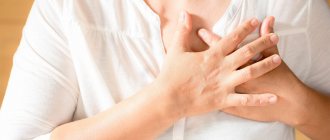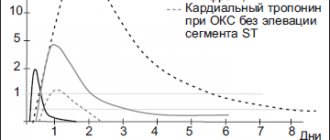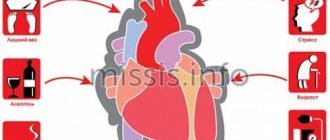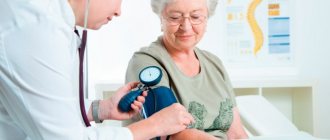When a person has a heart attack, they need to know what to do and responding quickly can help them achieve a better outcome.
A heart attack occurs when there is a blockage in blood flow to the heart, blocking the delivery of oxygen and other nutrients. This situation can damage or even kill parts of the heart tissue.
Although movies may show heart attacks to occur suddenly, many heart attacks start slowly and have many warning signs.
Signs and symptoms
A heart attack can cause pain in the shoulders and arms.
The main symptoms of a heart attack include the following:
- Chest pain or discomfort . Chest pain or discomfort may feel like pressure, tightness, or a squeezing sensation.
- Shortness of breath: Difficulty breathing, this may occur with or without chest pain.
- Discomfort in other parts of the body : back, arms and shoulders, neck or jaw.
- Heart rhythm disturbance
While both men and women can experience the initial signs and symptoms of a heart attack, the symptoms we've listed above are more common in men.
Women are more likely to experience additional signs and symptoms. These include:
- nausea and stomach upset
- abdominal pain
- cold sweat
- weakness
- sudden dizziness
- increased sweating
Symptoms of myocardial infarction at different stages of the disease
Signs of myocardial infarction differ at different stages of pathology development. During the disease there are 4 stages:
- stage of ischemia or acute period;
- stage of necrosis (acute period);
- stage of organization or subacute period;
- post-infarction period (scarring stage).
About 40% of all recorded heart attacks come as a surprise to the patient. Most often, doctors explain these by people’s inattention to their health. In the remaining 60% of cases, the disease is preceded for a long time by angina attacks.
The first signal to show concern is the appearance of pain in the chest, back, left shoulder or forearm, sometimes radiating to the jaw, ear and, less often, to the stomach and lower back. The nature of the pain varies: from mild and sluggish to acute and cutting. Typically, such pain appears after playing sports or during everyday physical activity, during emotional experiences and stress. These are the first signs of coronary heart disease. In nine out of ten cases, IHD develops due to vascular atherosclerosis (deposits of cholesterol in the inner walls of blood vessels) that supply blood to the heart muscle.
Such attacks can be observed in a patient from several weeks to two, three or more years and often, if not intervened, end in myocardial infarction. Have you noticed these in yours? Contact specialists immediately! Timely measures taken, diagnosis and observation by doctors will help avoid the development of the disease.
If coronary heart disease is not treated, then the next stage may be the most acute period of a heart attack.
What to do
A heart attack requires emergency medical attention. If someone has a heart attack, they should immediately call 112 for emergency help before doing anything else. Act quickly - it could help save someone's life.
First aid for myocardial infarction
Myocardial infarction is a type of ischemic heart disease characterized by irreversible damage to the heart muscle as a result of deterioration of blood flow through the coronary arteries
Characteristic signs (symptoms) of a heart attack (myocardial infarction):
- • sudden (paroxysmal) pressing, squeezing, burning, aching pain in the chest (behind the sternum) lasting more than 5 minutes;
- • similar pains are often observed in the left shoulder (forearm), left shoulder blade, left half of the neck and lower jaw, both shoulders, both arms, the lower part of the sternum along with the upper abdomen;
- • lack of air, shortness of breath, severe weakness, cold sweat, nausea often occur together and sometimes follow or precede discomfort/pain in the chest;
- • it is not uncommon for these manifestations of the disease to develop against the background of physical or psycho-emotional stress, but more often with some interval after them.
Uncharacteristic signs that are often confused with a heart attack:
- • stabbing, cutting, pulsating, boring, constant aching pain for many hours and not changing its intensity in the heart area or in a specific clearly defined area of the chest
Algorithm of actions in case of a heart attack
If you or someone else suddenly has the above characteristic signs of a heart attack, even with weak or moderate intensity, which last more than 5 minutes, do not hesitate, immediately call an ambulance team. Do not wait more than 10 minutes - in such a situation it is life-threatening.
If you have symptoms of a heart attack and there is no way to call an ambulance, then ask someone to take you to the hospital - this is the only right decision. Never drive yourself unless you have no other choice.
In the most optimal scenario, if a heart attack occurs, you must act according to the following algorithm:
- • Immediately after an attack occurs, sit down (preferably in a chair with armrests) or lie in bed with the head of the bed raised, take 0.25 g of acetylsalicylic acid (aspirin) (chew the tablet, swallow) and 0.5 mg of nitroglycerin (spray one inhalation dose into the cavity mouth while holding your breath, place one tablet/capsule under the tongue, first bite the capsule, do not swallow); free your neck and provide fresh air (open the vents or windows).
- • If after 5-7 min. After taking acetylsalicylic acid (aspirin) and nitroglycerin, the pain persists, it is imperative to call an ambulance team and take nitroglycerin a second time.
- • If pain persists 10 minutes after taking the second dose of nitroglycerin, it is necessary to take nitroglycerin a third time.
- • Give the patient a sedative (motherwort or valerian). There should be silence in the room, not allowing the sick person to become nervous.
- • If after the first or subsequent doses of nitroglycerin there is severe weakness, sweating, shortness of breath, you need to lie down, raise your legs (on a bolster, etc.), drink 1 glass of water and then, as with a severe headache, do not take nitroglycerin.
- If a person with a heart attack is unconscious and there is someone nearby who knows how to provide first aid in this situation, then you need to do it immediately!
Manifestations of the disease in women
Symptoms of a heart attack in women often appear after a strong emotional experience and a jump in blood pressure. Acute chest pain may be accompanied by dizziness, spots before the eyes and other manifestations of hypertension.
Sometimes the clinical course is atypical:
- Abdominal pain;
- Irradiation to the left arm;
- Feeling of discomfort in the chest;
- Tingling in the throat, under the left shoulder blade;
- Pain in the stomach or abdomen.
Women have a higher incidence of diabetes mellitus, which is associated with a high incidence of obesity and metabolic disorders during menopause. When combined with diabetes, the symptoms of damage to the heart muscle are erased, and pain may not be felt. It is difficult to recognize the disease in this state, so in such patients post-infarction changes may later be diagnosed on the ECG tape.
Among the atypical forms, the following predominate in women:
- Cerebral – headaches and dizziness, consciousness and understanding of what is happening is impaired;
- Colaptoid - pressure drops quickly, cold sweat appears, loss of consciousness occurs;
- Edema - swelling of the extremities, shortness of breath increases, ascites develops quickly - fluid accumulates in the abdominal cavity, enlarges it;
- Asthmatic - an attack resembles bronchial asthma, there is difficulty breathing, shortness of breath, and a cough.
The likelihood of pathology in women increases several years after the onset of menopause. The reason for this is changes in lipid and fat metabolism associated with estrogen deficiency and accelerated development of atherosclerosis.
What to do if symptoms appear
If a blood flow disorder develops, a person needs urgent help. It is impossible to stop the condition on your own, so you need to call an ambulance. Before her arrival, it is recommended to sit the person in a reclining position, unfasten the tight collar and belt to make breathing easier.
It is impossible to start treatment before the doctors arrive, as this may worsen the condition.
A serious complication is cardiac arrest. If there is loss of consciousness and no pulse, pulmonary-cardiac resuscitation should be started immediately. It includes chest compressions and mouth-to-mouth artificial respiration. Resuscitation measures are carried out on a flat, hard surface. The further prognosis and effectiveness of treatment in the hospital depend on the speed of first aid. But after an attack, the patient requires a period of rehabilitation. To do this, it is recommended to contact special rehabilitation centers after a heart attack, where they help restore health and return to an active life.
Causes and risk factors
A person needs to be aware of the risk factors so that they can take steps to prevent a heart attack.
There are some heart attack risk factors that people can control and others that they cannot.
Risk factors include:
- Age: men and women over 60 years old.
- Gender : Men are more likely than women to have and die from a heart attack.
- Family history: People with a family history of cardiovascular disease are more likely to suffer a heart attack.
- Race and ethnicity : Some ethnic groups, including African Americans, some Asians, and Mexican Americans, are more likely to have a heart attack than others.
Although people cannot influence the risk factors listed above, there are many risk factors they can change or treat to prevent a heart attack.
Modifiable risk factors for heart disease and heart attack include:
- obesity
- high blood pressure
- high cholesterol
- diabetes
- unhealthy diet high in saturated fat and sodium
- tobacco use
- excessive alcohol consumption
- not enough exercise
Causes of heart attack
The direct cause of a heart attack is the sudden occurrence of an obstruction to blood flow in the branches of the coronary artery. In 95–97% of cases, such an obstacle is a blood clot formed as a result of atherosclerotic lesions of the arteries. In other cases, a heart attack occurs without any manifestations of atherosclerosis, and the main cause is a pronounced prolonged spasm of the coronary artery.
In extremely rare cases, myocardial infarction develops as a complication of other diseases (arteritis, developmental anomalies and injuries of the coronary artery, infective endocarditis, etc.). The likelihood of symptoms of an acute heart attack increases several times if the following risk factors are present:
- hyperlipoproteinemia (abnormal increase in the level of lipids and/or lipoproteins in the blood);
- old age (55 years and older);
- male gender;
- physical inactivity (lack of physical activity);
- obesity;
- smoking;
- diabetes;
- hypertonic disease;
- hereditary predisposition (presence of IHD in blood relatives).
Preventing the risk of heart disease and heart attack
The best way to prevent a heart attack is to reduce any risk factors.
You can reduce your chances of having a heart attack:
- weight loss if you are obese or overweight
- treating high blood pressure and high cholesterol by consulting your doctor
- Controlling diabetes through diet, medications, and blood sugar control
- Eat a diet rich in fresh vegetables and fruits, low in saturated fats and processed foods
- quit smoking
- limit your alcohol consumption!
- at least 2-3 hours of moderate physical activity per week
Also, get regular checkups with your doctor. Regular screenings can help identify new risk factors for heart disease that a person may develop and monitor any existing ones.
Heart attacks are a medical emergency. Knowing the signs and symptoms of a heart attack can help a person get the help they need as early as possible. Reducing risk factors for heart disease can help a person prevent a heart attack.
Consequences of a heart attack
Myocardial infarction rarely goes away without leaving a trace. Its consequences in the form of complications can significantly reduce life expectancy. The most common complications of a heart attack are:
- early post-infarction angina;
- heart rhythm disturbances;
- cardiogenic shock (sharp decrease in myocardial contractility);
- acute cardiovascular failure;
- cardiac aneurysm (protrusion of the thinned wall of the heart);
- heart rupture (violation of its integrity).
After a heart attack, it is possible to return to a full life; the likelihood of this depends on many factors, including the timeliness and adequacy of treatment of the heart attack, the prevalence of tissue necrosis, and the presence of complications. Unfortunately, the mortality rate from a heart attack is high and amounts to about 35%. A third of those who have had the disease develop circulatory failure, in which people may lose their ability to work and become disabled.
Heart attack marked "urgent"
The disease acts quickly. Changes in the vascular wall lead to changes in its elasticity and narrowing of the lumen of the vessel. First, ischemia develops (blood supply decreases), and then at some point the plaque ruptures, a thrombus forms in the path of blood flow, it completely blocks the lumen of the vessel and causes necrosis of the myocardium. A heart attack is dangerous because if the blood supply to the myocardium is not restored in the first 6–12 hours after the cessation of blood flow, the heart may stop altogether.
Article on the topic
After a heart attack. What exercises will strengthen your heart?
But even if a heart attack occurs, it should not be fatal. Doctors have several treatment options to prevent a person from dying. It is possible to restore blood supply to the vessel that is closed by a thrombus by using thrombolysis (that is, dissolving the clot). Another way is to restore the patency of the vessel surgically by placing a stent. To do this, a special device is inserted through the artery, which opens in the right place like an “umbrella”, and thus expands and strengthens the vascular wall, restoring blood supply through it. The third method is coronary artery bypass grafting. Its essence is that in those arteries where blood flow is impaired, new bypass paths are created. This is done using healthy vessels that are attached to the coronary arteries.
Moreover, the earlier the diagnosis is made and treatment started, the better the survival prognosis. It is possible to save a person if doctors act immediately - open the lumen of the vessel. But how can you fit into the allotted “window” of 6–12 hours if it is not always possible to make a diagnosis of “heart attack”. 30% of heart attacks pass without pain, nausea, vomiting, or dizziness. In a fourth of cases there are not even changes on the electrocardiogram!
What is bypass surgery?
More details









